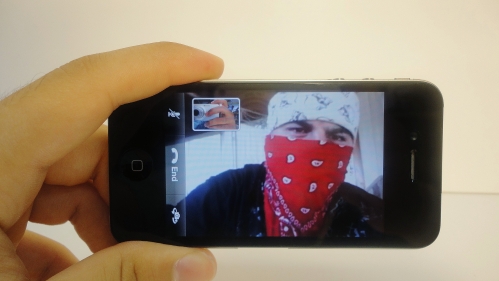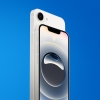Index
FaceTime Chat and Video Recording
As far as video capture is concerned, we are definitely impressed by the 1280x720p video capture with the new OmniVision CMOS sensor, although there are some stability issues with the lens. As Engadget Editor-in-Chief Joshua Topolsky notes, there is an all-too-familiar "jellyvision" CMOS issue that results from the sensor not having an anti-jitter algorithm, so it's crucially important to keep steady hands at all times when recording any video with the iPhone 4.
After a week and a half of casual video capture around the neighborhood, we wanted to take our new smartphone into an extreme environment to determine how persistent the "jellyvision" effect would be under very shaky circumstances. Last weekend, we attended Rockstar Mayhem Fest 2010 in San Bernardino, California and recorded our brutally epic experiences in the mosh pits while fists were being thrown around and heads were being crushed all around:
On the other hand, the front-facing VGA camera does an adequate job of capturing facial features and works surprisingly well in low-light environments. However, as we've mentioned, it's best to hold the iPhone 4 at least arm's length away in order to reduce the "fish eye" lens effect that may result if held too close.
This bring us to the topic of FaceTime video chat with the front-facing camera. In iOS 4, Apple has enabled the feature by default and allows iPhone 4 users connected via WiFi to initiate an outgoing video call by tapping on a contact's entry in the Contact Book and tapping the FaceTime button. For some reason, the iPhone 4 will apparently show the "FaceTime" call button for every contact in the address book regardless of whether or not that contact has an iPhone 4. We are convinced that Apple may eliminate this unnecessary display in the upcoming iOS 4.1 software fix, but as for now it may cause confusion to regular mobile videoconferencing users.
We have tested the FaceTime feature on several home networks with minimal latency and can attest to the fact that the video quality is much crisper and sharper than we had originally expected. In comparison to Qik for the HTC EVO 4G, the iPhone 4's 960x640 Retina Display gives it leverage in the video conferencing department for sharpest picture. However, the audio quality during a FaceTime call is no different than a standard phone call, and we are a bit disappointed that Apple decided to use the same audio codec for both communication protocols despite the increase in bandwidth availability over WiFi.

(FaceTime chat with a thug, in portrait mode)

(FaceTime chat with a thug, in landscape mode)
On another note, if standby mode is entered by pressing the iPhone 4's power button during a FaceTime call, the video will be disconnected and the iPod audio will be paused. Once the screen is turned back on, the FaceTime call will have already been closed, and the iPod audio will then be accessible for playback. We are also able to confirm that FaceTime audio and iPod audio can play simultaneously, with neither audio source having volume preference over the other.

(FaceTime conference multitasking with iPod audio playback)
Market Acceptance
It has been three weeks since Apple launched the iPhone 4 in the United States, the United Kingdom, France, Germany and Japan, with an international release set for July 28th. The phone was originally expected to become the most popular i-Product in history. Yet, we can confirm that this smartphone went above and beyond this achievement and sold over 1.7 million units in just 72 hours of launch. At the third week mark, it has probably sold more than 2.5 million units, but this figure remains to be confirmed.
"This is the most successful product launch in Apple's history. Even so, we apologize to those customers who were turned away because we did not have enough supply,” Apple CEO Steve Jobs said in a press release. At 1.7 million handsets sold in four short days with limited supplies, Apple grew its worldwide iPhone installed base by 3.4% to 51.7 million over launch-day weekend. In contrast, the iPad needed 80 days to reach 3 million sold when it launched earlier this year on April 3rd. Although not a necessary news flash to cite within this review, Apple has also surpassed Microsoft in total market cap as the most valuable IT corporation in the world.
After all, approximately 77 percent of iPhone 4 buyers on launch day were upgrading from a previous iPhone. It is safe to say that Apple has successfully built a recurring revenue stream in which most users will upgrade every one to two years, provided they receive upgrade incentives from AT&T in the form of subsidies. It is important to note, however, that the level of brand loyalty Apple has garnered is a significant factor in opening weekend sales and the success of its platform. According to an analyst report from Gene Munster, “The bottom line is this: 77 percent of new iPhone buyers were existing iPhone owners (upgrades), compares to 56 percent in 209 and 38 percent in 2008.”
The same survey also suggests that both 16GB and 32GB models of the iPhone 4 are being sold at roughly the same rate. Of the total respondents surveyed on iPhone 4 launch day, 54 percent of them had plans to purchase the 32GB model while 46 percent had plans to purchase the 16GB model. Whether those numbers held true during actual sales transactions remains to be seen, but the data suggests that many iPhone users do not express a need to fit more than 16GB of storage in their pockets.
We are led to assume that perhaps the company’s marketing team had already predicted this outcome and kept the 16GB and 32GB models for the sake of maintaining profit margins. Back in December 2009, Toshiba announced its largest 64GB NAND-flash chip, the highest capacity yet achieved in the industry. Of course, rumors abounded that Apple wouldn’t hesitate to include this new 64GB module in its fourth-generation iPhone lineup, but the announcement at WWDC 2010 and release on June 24th shows that it didn’t happen.
It’s still interesting to point out that within Apple’s third-generation iPod touch lineup, released in September 2009, there is a 64GB model available for $399. Based on this observation, we are confident that Apple’s fifth-generation iPhone lineup next summer will include a 64GB model, but we won’t have a confirmation for quite some time.
Conclusion
The iPhone 4 is an incredibly unique smartphone device that builds on a 3 year tradition in the Apple mobile product ecosystem. For the average consumer, it offers a significant improvement in battery life over its predecessors and promises to deliver up to 7 hours of 3G talk time and up to 6 hours of continuous Internet browsing over 3G. As a device for making voice calls, it has enough juice to last throughout an entire day and provides an incredible amount of standby power even in the most extreme conditions where battery percentage is barely hanging in the single digits.
For the enthusiast consumer, its variable clockspeed A4 SoC and 512MB of system memory are adequate enough to provide a seamless multitasking experience within the iOS software platform. From a network perspective, the improved baseband hardware gives the iPhone 4 more performance as a cloud-based mobile device and delivers exceptionally improved HSUPA upload speeds in the range of 1Mbps - 1.24Mbps with lower latency than its predecessor. It's conveniently useful for any context where uplink and downlink data throughput rates are of highest priority, and as far as we recall, AT&T is still the fastest 3G HSPA network in the United States (not HSPA+) despite many ongoing grudges towards its service. Simply put, Apple signed an exclusive 5-year agreement with AT&T, and both are required legally adhere to strict terms and agreements until that contract expires in summer 2012. If a cynical argument is going to exist about network quality and coverage, it's going to be with AT&T rather than with Apple.
For each and every consumer in the smartphone market, the iPhone 4 features a surprisingly high-end front and back camera system that allows users to capture still shots and videos with confidence in an improved 5MP 1.3/2" CMOS sensor with lightning fast shutter speeds in comparison to other flagship smartphones available in Q3 2010. Apple has also gone above and beyond many expectations with its Retina Display, a 960x640 326ppi IPS-based LCD that single handedly outshines any competitor in terms of resolution density and image clarity at this point in time.
As many analysts have noted, there are some viable alternatives to the iPhone 4 that may have an almost identical feature package but a slightly different form factor (and operating system for that matter). Nevertheless, when it comes to the total package - the iPhone 4's compact hardware form factor combined with its exceptional display, snappy Cortex A8-based A4 processor and 512MB of memory provide an incredibly productive mobile computing landscape within iOS and serve all of our day-to-day purposes with ease and without complaints.





